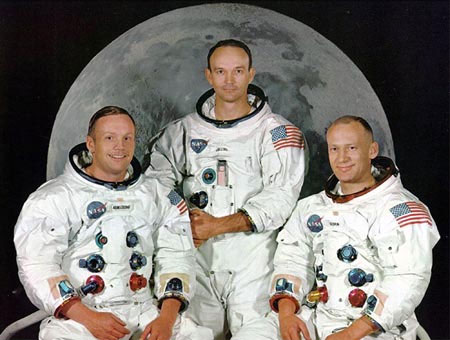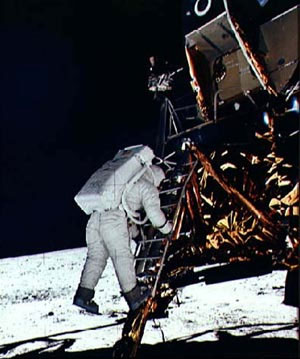|
 Apollo 11 astronauts (L-R) Neil Armstrong, Michael Collins and Edward "Buzz Aldrin pose in this file photo. Tuesday July 21, 2009 marks the 40th anniversary of the moon landing. [Xinhua]
Apollo 11 astronauts (L-R) Neil Armstrong, Michael Collins and Edward "Buzz Aldrin pose in this file photo. Tuesday July 21, 2009 marks the 40th anniversary of the moon landing. [Xinhua] |
WASHINGTON: The US NASA (National Aeronautics and Space Administration) released Thursday newly restored video from the July 20, 1969, live television broadcast of the Apollo 11 moonwalk, to commemorates the 40th anniversary of the first mission to land astronauts on the moon.
The initial video release, part of a larger Apollo 11 moonwalk restoration project, features 15 key moments from the historic lunar excursion of Neil Armstrong and Buzz Aldrin.
NASA lost its original moon landing videotapes and after a three-year search, officials have concluded they were probably erased. So the restoration has four other video sources: CBS News originals; kinescopes from the National Archives; a video from Australia that received the transmission of the original moon video; and camera shots looking at a TV monitor.
|
 Apollo astronaut Edwin E. "Buzz Aldrin Jr., lunar module pilot, descends the steps of the Lunar Module (LM) ladder as he prepares to walk on the Moon in this July 29, 1969 file photo. [Xinhua]
Apollo astronaut Edwin E. "Buzz Aldrin Jr., lunar module pilot, descends the steps of the Lunar Module (LM) ladder as he prepares to walk on the Moon in this July 29, 1969 file photo. [Xinhua] |
"The restoration is ongoing and may produce even better video," said Richard Nafzger, an engineer at NASA's Goddard Space Flight Center, who oversaw television processing at the ground tracking sites during Apollo 11.
"The restoration project is scheduled to be completed in September and will provide the public, future historians, and the National Archives with the highest quality video of this historic event," Nafzger said Thursday at a news conference at the Newseum in Washington.
NASA contracted with Lowry Digital of Burbank, California, which specializes in restoring aging Hollywood films and video, to take the highest quality video available from these recordings, select the best for digitization, and significantly enhance the video using the company's proprietary software technology and other restoration techniques.
Under the initial effort, Lowry restored 15 scenes representing the most significant moments of the three and a half hours that Armstrong and Aldrin spent on the lunar surface.

